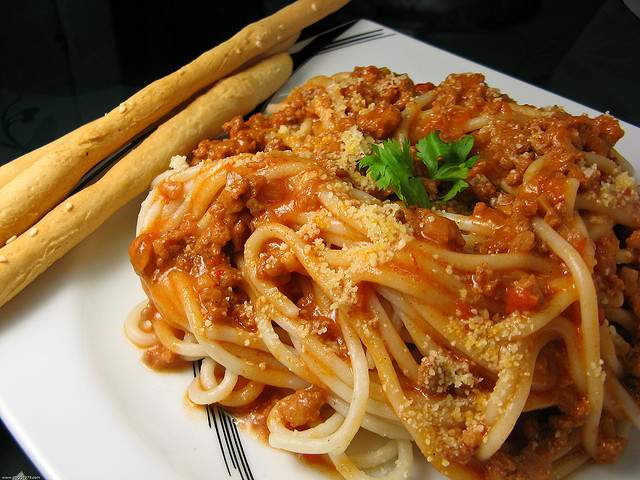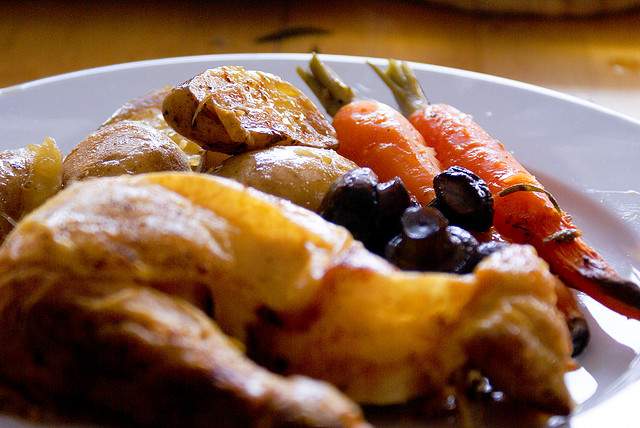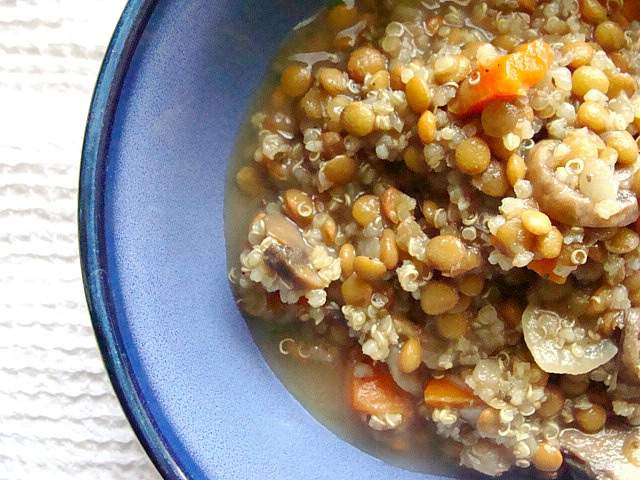As you travel, foods from foreign lands may become incorporated into your repertoire, and you may learn how to adapt foreign tastes to recipes from home. Food is, in many ways, a cultural ambassador. Some of my favorite recipes have come from friends abroad – having kaffee und kutchen (coffee and cake) with my German friend, or exchanging treats with the South African family down the hall. With them, I share my favorite versions of American food – biscuits and gravy, carnitas, pico de gallo, shrimp etouffee, chocolate chip cookies.
Sharing food customs with each other is a great way to get to know people of other cultures, but learning the basics of cooking will also help with your budget, particularly if you are traveling long-term.
Food is, in many ways, a cultural ambassador. Some of my favorite recipes have come from friends abroad.
Recipes
Here are some of my favorite recipes for cooking abroad, whether you’re staying in a hostel and cooking with new friends or renting a condo or house for your time abroad. They aren’t meant to be cookbook recipes, with precise directions and measurements, but more guidelines to help travelers with ideas when dealing with foreign ingredients.
Pasta

Pasta is my go-to easy meal.
For an easy dinner, just follow the directions below and add your own spin to it:
- Roughly chop an assortment of veggies, toss them in oil, salt & pepper, and roast in a medium oven (350 to 400 degrees Fahrenheit) until soft and brown around the edges. (Eat one if you’re not sure if they’re done!)
- Cook noodles according to directions
- Toss cooked veggies with cooked pasta and serve hot or warm.
- If you don’t have an oven, you can get much of the same effect by sautéing in a pan.
Here are some combinations to try:
- Tomatoes & onions, with chopped black olives added with the pasta
- Broccoli, with grated parmesan and a generous squeeze of lemon added to the pasta
- Asparagus, with chopped cooked bacon or pancetta and a dash of balsamic vinegar
- Butternut squash and onion, topped with chopped walnuts
Of course, there’s also the classic Italian-American meat sauce
- Brown a pound of ground meat – preferably beef – in a large pan.
- Add chopped onions, carrots, garlic, and herbs, if desired.
- Add a splash of red wine. Save the rest for the chef.
- You can use fresh or canned tomatoes, but if you get canned, buy the whole tomatoes, not pre-chopped or pureed. You’ll get a better tomato flavor that way (and I actually prefer canned so I don’t have to chop and peel fresh ones). Either way, remove all the peel and crush the tomatoes with your hands.
- Add them to the pot with all the juice from the can.
- Cover, and cook over medium-low heat for several hours – the sauce should bubble but not boil over. It’s done when the tomatoes have softened significantly and the sauce is, well, “saucy”.
Sopa de fideos is one of my favorite easy things for a cold day
It’s usually made with fideos, which are short, thin noodles, but you can substitute any tiny pasta or simply break up spaghetti into inch long segments.
- Pop a tomato, skin and all, into a pot of chicken broth.
- Simmer until the tomato begins to fall apart. Add noodles and cook until done.
- Serve with lots of noodles and some bits of tomato in each bowl.
Meat

Why use an oven?
You might notice that I’ve mentioned the use of an oven quite often in many of these recipes. The reason is that I find oven cooking to be more forgiving than stovetop, which can be a blessing when dealing with an unfamiliar kitchen. Also, you can bake or roast in pretty much any oven safe vessel, or even on foil in a pinch, without worrying about having the right pots and pans.
All these recipes can be adapted for use on a stove top if that is all you have, though.
Pork butt
Pork butt, or shoulder (both terms for the same cut of meat), is one of my favorite cuts of meat. It is usually pretty cheap, easy to cook, and delicious. Because it’s fatty, long and slow cooking turns it into fall apart pieces, which can be shredded with a fork, and a little goes a long way.
- Wrap it in warm flour tortillas with fresh tomato salsa
- Make pulled pork sandwiches.
- Shred it onto rice or warm, smashed potatoes. It’s easy, full of flavor, and a true crowd pleaser.
Tip: if you’re going to be buying meat in a foreign country, it may be helpful to bring a little butchering diagram of cows, pigs, etc. Otherwise, you’re going to be doing some interesting pantomime to convey the parts of the animal you want to buy. I tend to stay away from things like steak or tenderloin when abroad, since both the cuts and the flavor/marbling of the animals will be different than you expect in the U.S., and our usual cooking techniques may not work as well. Ground meat and cuts for slow cooking (think roasts, stews, braises) are safer bets.
A basic guide for cooking pork butt
- Combine the pork, a liquid, a roughly chopped onion, and heat of some kind, if you wish.
- You can use whole jalapenos, canned chipotles, or even green pepper for the heat.
- For the liquid, you can use beer, cider, stock, orange juice, or even soda.
- Pour in enough to mostly cover the meat.
- You can leave the meat whole, or cut it into strips, chunks, or cubes. Either way works, but I prefer cutting it into rather large chunks, which helps it cook more quickly, which is necessary if you’re doing this in a hostel. If you have your own space, though, do it however you wish.
A pork butt is best smoked, but travelers typically don’t have access to a grill, so cooking in the oven, on low heat (250-300 degrees Farenheit until the internal temperature is 190 degrees), is the way to go.
If you don’t have access to an oven, pork butt can also be braised on the stovetop. If you do it on a stovetop, be prepared to check the meat often once most of the liquid has evaporated to keep it from completely sticking to and burning the bottom of your pot. You can leave some liquid for a saucier dish, or let most of it evaporate, if you like crunchy bits and pieces mixed in with the rest of the meat. Expect chunks to take about 3 hours and a whole butt to take up to 6.
A couple of baggies of bulk spices from home doesn’t take up too much room, but are a great way to bring the taste of home with you.
Chicken
Turkey might be hard to come by overseas- at least the huge Thanksgiving birds we’re used to over here – but you can always roast a chicken and have a veritable feast.
- Wash the bird and take out an extra flaps of skin, gizzards, etc.
- Salt and pepper thoroughly inside and out, and stuff some herbs under the skin if you wish.
- Prep some veggies if you want to roast them with your chicken.
- Roughly chopped onion, carrots, parsnips, and celery are all good.
- Toss them in a little oil, salt and pepper, and layer them on the bottom of your roasting vessel.
- Turn the oven on hot – about 450 to 500 degrees Fahrenheit- and have some foil ready in case the skin starts to blister.
- Prick a lemon or orange all over with a sharp knife and if you can, microwave it for 15 seconds. Stuff the lemon or orange into the chicken.
- Place the chicken on the veggies, breast side up. Keep an eye on your chicken, and if the skin starts to burn, make a little tent out of the foil and drape it over the breast, legs, and wing tips.
- After 20 minutes, flip the chicken and roast for another 20 minutes. Flip it back over for the last 10.
- Cook until the chicken breast reaches an internal temperature of at least 150-155 F and the thighs and legs reach 170 F.
Veggies

Salsa
A great way to get your fresh veggies, especially with the roast pork above, is to make some fresh tomato salsa.
- Chop half an onion about as small as you can, and add the juice of half a lime.
- Chop and seed several tomatoes (a pound or so) into medium dice.
- Chop fresh cilantro.
- Mix with the onion and plenty of salt.
- Use to top tortillas, dip chips, or even straight out of the bowl.
Salad and salad dressing
Your basic vinaigrette salad dressing can be “dressed up” in endless ways.
- Mix 1 cup oil with ½ cup vinegar or lemon juice.
- Shake vigorously in a jar to combine.
- Add salt, pepper, and any of the following (listed from most to least in amount to add; adjust to your taste):
- Several cloves of garlic, roasted in their skins until soft
- Coarsely crumbled blue cheese, parsley
- Equal parts mustard and honey
- Sugar, basil, oregano, and parsley
I love to take the leftover salad and layer the wilted greens on crusty bread the next day, letting the dressing soak into the bread. Add cheeses, roasted veggies, and/or lunchmeat for an easy and delicious leftover salad sandwich.
Did you know there are over 70 articles about food around the world on BootsnAll?
Beans

They say beans are the budget cook’s best friend. Besides filling you up, they provide a ton of good nutrients and are usually pretty inexpensive. But I never thought I’d find myself craving lentils until my friend Joni shared her recipe with me. I’ve been preaching the lentil gospel ever since. Even better: this dish can totally be made with different kinds of beans, and to turn it into a soup, simply by increasing the amount of liquid.
Lentils
- In a large pot, cook some chopped carrots and onions with either chopped up pieces of bacon, or, for a vegetarian version, the fat of your choice.
- Add a generous pinch of thyme.
- Add a pound of dried lentils and 4 cups of chicken (or vegetable) broth.
- Bring to a boil, reduce heat, and simmer until tender, about an hour, depending on your water hardness.
- Most bags of dried beans will have recommended cooking times on the side of the bag.
Don’t forget to soak other, larger beans ahead of time. Serve on rice, with a fried egg or a side of sweet potatoes. Delicious!
Cooking gear to add to your packing list
If you already love to cook and you like to stay in hostels with shared kitchens or prefer to rent apartments or houses for your accommodations as you travel, then you most likely bring some of your favorite kitchen gear with you on the road.
If I’m driving, my favorite knife always comes with me on my travels. I have even checked in my luggage a few times while flying (I’m kind of crazy about having my own knife).
Even if I’m flying somewhere, or even if I’m traveling for months at a time, I still usually add a few of the staples below to my packing list:
- If you’re really serious about baking & cooking while traveling, you may find it worth your time to invest in a small kitchen scale like this one.
- You will also find it convenient to memorize, or have a handy way to look up, metric to US units. A measuring cup like this one is my best friend. It shows ounces, cups, tsp and Tbsp.
- Finally, a couple of baggies of bulk spices from home doesn’t take up too much room, but are a great way to bring the taste of home with you.
- I carry salt and pepper, paprika, chili powder, garlic powder, and an italian seasoning blend
What are some of your favorite travel recipes and must have tools? Comment below, so we can do a follow up article with a collection of travel recipes.
To read more about food and cooking while on the road, check out the following articles and resources:
- Pho 101 – A Beginner’s Guide to Vietnam’s Most Famous Dish
- 10 Delicious Discoveries with Intrepid Travel
- 11 Great American Sandwiches Worth the Trip
- A Dish for All Seasons: What to Eat (and When to Eat it) Around the World
- 10 Bizarre Desserts that Shouldn’t Taste So Good
- 12 Mouth-Watering Vegetarian Dishes Worth Traveling For
- The Best Travel Souvenir: Cooking Classes Abroad
- 8 Traditional Dishes to Learn to Cook While Traveling
Photo credits: dbgg1979, vauvau, lablascovegmenu, ErinKPhoto, Vegan Feast Catering
